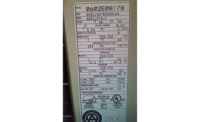Bob had changed a compressor on a 5-ton air conditioner that cooled the clubhouse at an apartment complex. He was just about ready to charge the unit when a problem came up. He had added a liquid line drier and sight glass just after the drier at the outdoor unit and had leak checked the connections that he had made and was satisfied there were no leaks. He had pulled a vacuum down to 500 microns on his electronic vacuum gauge and was letting it sit for a few minutes and he noticed a rise in the vacuum gauge to 1,000 microns. He was scratching his head when Btu Buddy asked, “What is the problem, Bob? You looked puzzled.”
Bob described what he had done, then said, “This system is 15 years old and has never had refrigerant added to it according to its history. I don’t get it; there should not be a leak.”
Btu Buddy asked, “Why did you change the compressor?”
Bob explained, “The compressor was just turning, not pumping, so I changed it. I will need to start it up to explore what the problem may be.”
Meanwhile the vacuum gauge had climbed to 1,500 microns. There was a leak somewhere. Bob asked, “Could there be moisture or refrigerant in the system still boiling and making the pressure rise?”
Btu Buddy said, “It is not likely. Let’s just let it sit for a few more minutes and see. If it is moisture or refrigerant still in the lines, it will stop soon. It is not likely that you could have lowered the pressure to 500 microns with water or refrigerant still in the system.”
They waited for 30 minutes and Bob examined the system while waiting. He changed the filters, oiled the motors, and while he was at the evaporator he found a potential problem, but it didn’t have anything to do with the possible leak.
Bob said, “The expansion valve bulb is loose on the suction line at the evaporator. It looks like someone just loosened it for no reason.”
Btu Buddy explained, “Some older technicians who only go by the touch system of checking superheat may have loosened it to get more refrigerant flow, most likely while touch testing the suction line. The problem with that is they would not know how much more flow they created.”
Bob said, “I bet that is what ruined the compressor. I bet the oil in the crankcase was washed out and the bearings seized and the crankshaft broke. You could hear the old compressor turn, but nothing happened. It had very low amperage when I checked it.”
Btu Buddy said, “That is a good assessment of what may have happened. How does the vacuum look?”
Bob said, “It is up to 2,500 microns.”

Figure 1. This valve arrangement can isolate
the vacuum pump from the sensor and the sensor from the system. (Figures are
from Refrigeration & Air Conditioning Technology,
5th Edition, by William Whitman, William Johnson, and John Tomczyk, published
by Thomson Delmar Learning.) (Click on the image for an enlarged view.)
Bob turned off the valve to the vacuum gauge and added the refrigerant and nitrogen (Figure 1). He then used his leak detector to leak check his own gauges and connections he had made for pressure testing and found them all to be good.
He then started over the connections at the compressor and the drier and sight glass connections.
Bob said, “Wow, there is a small leak around this sight glass connection that I don’t believe was here before.”
Btu Buddy then said, “It may not have been there when you leak checked it. Notice that connection is made with 45 percent silver because the connection is brass and you had to use flux to make the connection. Take a close look at where the leak is. Use soap to pinpoint the leak. Tell me what you find.”
Bob looked close and said, “It looks like the leak is under a bubble of flux.”

Figure 2. This illustration shows how a leak
can be covered up by the flux. If the flux had not popped up with pressure on
the system, it would have been sucked into the hole and would appear later
during normal operation. (Click on the image for an enlarged view.)
Bob let the nitrogen and trace of R-22 out of the system and repaired the leak. This time he used a screwdriver tip to chip away the flux after it had cooled. He then pressurized the system again and there was no more leak. He then let out the nitrogen and started the vacuum pump.
As the vacuum pump ran, Bob said, “I could have saved some time on that one. I can’t really charge the customer for that mistake that cost about an hour of labor.”
Btu Buddy said, “Well, some technicians would charge the customer anyway, but they are not treating the customer like they would like and expect to be treated.”
When the vacuum pump was shut off at 500 microns, the system was allowed to sit for 15 minutes and there was no rise in the micron reading.
Bob then said, “I am going to charge the unit and consider it repaired after startup.”
Btu Buddy said, “Don’t you think that you should check the superheat after startup? You shouldn’t just presume the valve is working correctly.”
Bob charged the unit and checked the superheat at the condensing unit and it was 15°. The line set was about 35 feet long, so this looked about right. He then said, “Well, another lesson that turned out OK. I didn’t charge the customer for the extra time that I wasted in haste.”
Btu Buddy then said, “That is the best thing to do; be fair and honest.”
Publication date:10/22/2007







